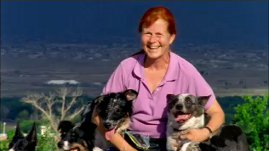Teachers' Domain - Digital Media for the Classroom and Professional Development
User: Preview

Source: WILD TV: "The Animals We Live With"


Funding for the VITAL/Ready to Teach collection was secured through the United States Department of Education under the Ready to Teach Program.
Animal shelters euthanize animals when no one adopts them. According to Joyce, the narrator of this segment, 26,000 dogs a year are picked up by Albuquerque Animal Services. To help find homes for the unwanted pets, Joyce, who is also a photographer, takes pictures of the dogs and posts the pictures on the Internet. She hopes when people see the dogs on the Internet they have an added incentive to come to the shelter to take them home. In this video segment from WILD TV, learn more about Joyce and her efforts to find homes for unwanted pets in Albuquerque. For more about animal shelters, see video segment "Animal Shelter".
Science, Social Studies, Animals
The following Frame, Focus and Follow-up suggestions are best suited for elementary or middle school students using this video in an English language arts or social studies lesson. Be sure to modify the questions to meet your students' instructional needs.
What is Frame, Focus and Follow-up?
For an ELA lesson on inference:
For an ELA lesson on author's purpose:
For a social studies lesson:
JOYCE FAY: Everyday they’re putting them down, - wonderful dogs that get put down because there just aren’t people coming through, to adopt them. I mean she’s, a great dog.
JOYCE: Where we are now is one of the two facilities of Albuquerque Animal Services. It’s one of the two, what we used to call dog pounds and now they call them shelters.
JOYCE: They’ll hold them for seven days, to give the owners a chance to reclaim them. After that, theoretically they can put them down the next day. At some point somebody said, her time’s up.
JOYCE: I’m not blaming the shelter, they don’t have a choice, it’s not their fault that there are 26,000 dogs a year, that they pick up in Albuquerque.
JOYCE: I photograph as many animals as I possibly can in all of the shelters, and also rescue organizations. So that somebody will know what’s out there. And know where to look.
JOYCE: I started especially photographing my own animals, my dogs Bro and Tracy and also our horses, and I was doing that and I also photograph other people’s animals. I love it when I have the opportunity to photograph well-loved animals.
JOYCE: I knew that people would look, if I made good pictures and put them on the Internet that people would come, and look at the pictures there. And then often they say, “Okay then I can go and get that one,” you know.
MARIA WARREN: I saw that she had a web address and I went out there thinking I would find out about here professional business, but instead there was page after page of pictures of animals available for adoption at the area shelters here. And I thought that was a wonderful thing.
JOYCE: There’s something about our relationship with dogs, that’s, I think, unique, even with our relationship with other domestic animals. There’s something that they do for us; there’s some spirit of dog.
MARIA: One day I saw a picture of Ralph. He’s a one year-old, full-blooded Jack Russell terrier male. And he was at the Westside Animal Control, available for adoption and my husband and I went down the next day and got him.
JOYCE: It does help - the publicity they get whether in the newspaper or Internet and so on - does help a lot of them get adopted.
JOYCE: And if animals, especially shelter animals, and so on, if that is something that you care about, get in touch with your shelters and your rescue organizations in your area, and find out what you can do.
JOYCE: And an animal is saved, just because you made a phone call. And when that happens you’re just like ah, you know, and it really tells you to encourage everybody to do what they can, you know - because we all feel so frustrated, we can’t, we can’t do anything about all the problems in the world you know.
JOYCE: And then you find out, oh, well sometimes just making a phone call, or just going out and making whatever effort you can about what you care about, will make a difference. And if everybody just did a little bit, imagine the difference it would make in the world.
TITLE CARD: Every year over 15 million cats and dogs are put to sleep in U.S. animal shelters.
 Loading Standards
Loading Standards